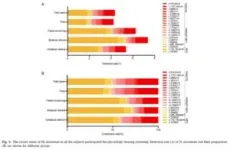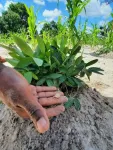(Press-News.org) Researchers from the Veterinary Education, Research, & Outreach (VERO) program at the Texas A&M School of Veterinary Medicine & Biomedical Sciences (VMBS) have received $300,000 from the United States Department of Agriculture’s National Institute of Food and Agriculture to study the costliest disease in the cattle industry, bovine respiratory disease (BRD).
The grant will fund a highly collaborative project involving Mississippi State University, West Texas A&M University and Texas A&M AgriLife that looks at the effects of vaccination and management strategies on the cattle immune system and microflora, specifically as it relates to BRD.
BRD costs the cattle industry around $1 billion each year in prevention, management and treatment fees, as well as in herd losses. Though scientists have studied BRD for decades, the ability to accurately predict which individual animals will contract BRD remains elusive, making management strategies less effective.
Old Problems
For the last 50 to 60 years, BRD has been the No. 1 cause of disease and death in cattle feedlots of North America. It has a high morbidity rate, accounting for 35 to 50% of all diagnosed disease, which means that infected herds often experience significant losses.
Despite having been the focus of research for decades, BRD is difficult to prevent because there are many factors that can affect whether an individual animal contracts BRD.
“Age, proximity to other cattle with BRD, vaccination status and individual immune response are just some of the contributing factors,” said Dr. Matthew Scott, an assistant professor of microbial ecology and infectious disease at VERO.
The variety of factors can make it hard to predict exactly which animals will get sick and which ones will resist infection.
“Sometimes low-risk cattle still get sick,” Scott said. “Sometimes really high-risk cattle — the ones coming from multiple sources with no management or vaccines at all — don’t get sick. So, there’s a lot of incongruences at the individual level and we don’t really know why.”
Vaccines and management strategies, such as physically separating cattle that are vulnerable to BRD, are typically the most reliable way to keep cattle healthy.
“Those are the two main tactics we have in preventing BRD,” Scott said. “We can use these tactics to predict whether a herd is at high or low risk for BRD infection, which is information crucial to producers who may be buying or selling those animals.”
Separating out animals that have been deemed vulnerable to BRD can mean keeping them away from commercial sale barns, where hundreds or thousands of animals may be brought together, putting their immune systems in jeopardy and making it easier for BRD to spread.
“It’s the equivalent of having your kid start kindergarten,” Scott said. “All these kids go to school for the first time, and after the first week everyone has a runny nose. Cattle can be no different in that regard.”
Unfortunately, risk assessment only helps scientists predict general patterns of BRD transmission; it hasn’t been successful in predicting which individual cows will get sick.
New Strategies
The goal of the new NIFA-funded project is to try to understand what makes some cattle more susceptible to BRD than others. Scott and his team expect the project to take about two years.
“We have two main objectives,” Scott said. “First, we’re going to take samples from a variety of cattle and keep track of them throughout their entire life cycle. This way, we can know which cows eventually get sick and which ones don’t. Then, we can look at their gene expression and see what may be affecting their immune systems on the molecular level.
“Secondly, we’re going to look at samples taken from the upper respiratory tracts of these animals to analyze the microbial community — things like bacteria, viruses and fungi that may be present — so we can understand how they may be affecting the cattle’s internal ecosystem,” he said.
This stage of the project will also include examining what is called the host transcriptome, which is the measurement of all the messenger RNA in an animal at a given time. Having all that information allows researchers to see the expression and function of approximately 20,000 genes at one time.
Comparing the microbial community with the host transcriptome will give researchers an incredibly detailed picture of what’s going on inside cattle respiratory systems at the cellular and molecular level. Together with the life cycle data, Scott and his team will be able to see what factors impact susceptibility at both the macro and micro levels to an unprecedented degree.
To get the necessary data, Scott’s team will collaborate with several cattle facilities, including the AgriLife Beef Management Station in Bushland and Prairie Livestock in Mississippi, which is affiliated with Mississippi State University.
Scott’s team will also partner with West Texas A&M University for sample collection and data analysis.
Ongoing And Future Directions
Conveniently, the new project shares quite a bit of overlap with an ongoing VERO-led research project that is now in its third year, in collaboration with AgriLife, Mississippi State University, Kansas State University and West Texas A&M University. In fact, the new project will collect samples from the same groups of cattle as the ongoing one, which saves time for the researchers.
“The ongoing project takes a more traditional epidemiological approach,” Scott said. “We’re looking at how different management strategies and the use of vaccination influence rates of BRD in cattle using health markers in the blood. For example, how much does choosing not to move calves through a sale barn keep them safe from infection?”
The information from the combined projects goes toward assisting researchers in developing new and more effective strategies, including vaccines, for helping prevent, detect and treat BRD.
“Given how much the industry loses to BRD, the economic benefits of the research can’t be overstated,” Scott said.
END
Texas A&M-led team receives USDA grant to study cattle respiratory disease prevention
2023-10-12
ELSE PRESS RELEASES FROM THIS DATE:
$150M grants will drive new era in Alzheimer's treatments
2023-10-12
A new study will combine an Alzheimer’s medication that slows disease progression in some patients with two other drugs to see if their effects can be amplified. The trial will be the first to test drugs acting on two disease-driving proteins, amyloid and tau, for patients with late-onset Alzheimer’s, the most common type of dementia.
The trial will recruit 900 participants with early Alzheimer’s at UC San Francisco and other sites nationwide. It is funded by a grant from the National Institute on Aging, part of the National Institutes of Health. It is awarded to Adam Boxer, MD, PhD, principal investigator and project ...
"Two-factor" screening of newborns enhances congenital hearing loss management
2023-10-12
Nearly 30 million Chinese individuals experience hearing loss (HL), with around 60% of these cases being hereditary. HL is the second most common congenital disability in China, with an estimated 30,000 babies in China born with HL each year and face the challenges of medical expenses and education-related issues.
To understand if concurrent hearing screening and high-throughput genetic screening could improve the effectiveness of newborn HL programs, a new study by Minghong Zhao, Xuemei Luo, Qinfei ...
Astronomy: One small step towards lunar roads
2023-10-12
It may be possible to create paved roads and landing pads on the Moon by using lasers to melt lunar soil into a more solid, layered substance, reports a proof-of-concept study in Scientific Reports. Although these experiments were carried out on Earth using a substitute for lunar dust, these findings demonstrate the viability of the technique and suggest it could be replicated on the Moon. However, further work may be needed to refine the process, according to the authors.
Moon dust poses a significant challenge to lunar rovers as, due to the low levels of gravity, ...
AI just got 100-fold more energy efficient
2023-10-12
AI is so energy hungry that most data analysis must be performed in the cloud
New energy-efficient device enables AI tasks to be performed within wearables
This allows real-time analysis and diagnostics for faster medical interventions
Researchers tested the device by classifying 10,000 electrocardiogram samples
The device successfully identified six types of heart beats with 95% accuracy
EVANSTON, Ill. — Forget the cloud.
Northwestern University engineers have developed a new nanoelectronic device that can perform accurate machine-learning classification tasks in the most energy-efficient ...
Around the globe, climate adaptation lacks coordination
2023-10-12
Viewed globally, it is above all individuals and households that are pursuing adaptation to the impacts of climate change; systematic networking of the various groups affected is lacking. This is the conclusion reached by an international team of experts from Universität Hamburg’s Cluster of Excellence for climate research (CLICCS) and Ludwig-Maximilians-Universität München (LMU). Their meta-study was just released in the journal Nature Climate Change.
For their meta-study, the 30 authors analyzed more than 1,400 academic studies on climate change adaptation. By doing so, they offer the first global overview of which groups of actors are pursuing adaptation – and ...
Red blood cell transfusion in the ICU
2023-10-12
About The Study: Red blood cell (RBC) transfusion was common in patients admitted to 233 intensive care units in 30 countries between 2019 and 2022, with high variability across centers in transfusion practices. Although many different clinical reasons and triggers were stated for RBC transfusion, the three most common reasons (low hemoglobin level, active bleeding, hemodynamic instability) and triggers (hypotension, tachycardia, no physiological trigger affected the decision to transfuse) were largely overlapping in all regions.
Authors: Alexander P. J. Vlaar, M.D., Ph.D., M.B.A., of Amsterdam University Medical ...
Small-volume blood collection tubes to reduce transfusions in intensive care
2023-10-12
About The Study: This randomized trial in 25 adult medical-surgical intensive care units (ICUs) in Canada found that the transition from standard-volume to small-volume tubes for blood collection in the ICU may reduce red blood cell transfusion without impacting biospecimen sufficiency for laboratory analysis.
Authors: Deborah M. Siegal, M.D., M.Sc., of McMaster University in Hamilton, Ontario, Canada, is the corresponding author.
To access the embargoed study: Visit our For The Media website at this link https://media.jamanetwork.com/
(doi:10.1001/jama.2023.20820)
Editor’s Note: Please see the article for ...
The burden of lung cancer in women compared with men in the US
2023-10-12
About The Study: Based on high-quality population-based data, this study found that the higher lung cancer incidence in women than in men has not only continued in individuals younger than 50 years but also now extends to middle-aged adults as younger women with a high risk of the disease enter older age. Reasons for this shift are unclear because the prevalence and intensity of smoking are not higher in younger women compared with men except for a slightly elevated prevalence among those born in the 1960s.
Authors: Ahmedin Jemal, D.V.M., Ph.D., of the American Cancer Society in Atlanta, is the corresponding author.
To access the embargoed study: ...
Race and ethnicity and primary language in emergency department triage
2023-10-12
About The Study: In this study of 249,000 visits to seven academic and community hospital emergency departments, patients who identified as Black, Hispanic, and Other race and ethnicity were assigned less acute Emergency Severity Index scores than their white peers despite having received more involved physician workups, suggesting some degree of mistriage. Clinical decision support systems might reduce these disparities but would require careful calibration to avoid replicating bias.
Authors: Joshua W. Joseph, M.D., M.S., ...
Big blood savings: large trial in JAMA shows taking less blood for lab testing reduces transfusions in intensive care
2023-10-12
A world-first clinical trial published in JAMA could provide an easy way to save tens of thousands of units of blood every year in Canada and much more worldwide. The trial, which involved more than 27,000 patients in 25 adult intensive care units (ICUs) across Canada, showed that taking less blood for lab tests using “small-volume” tubes reduced the need for almost one blood transfusion for every 10 patients.
Most hospitals use standard tubes that automatically draw four to six milliliters (ml) of blood, but a typical laboratory test requires less than 0.5 ml of blood, meaning the rest (more ...



